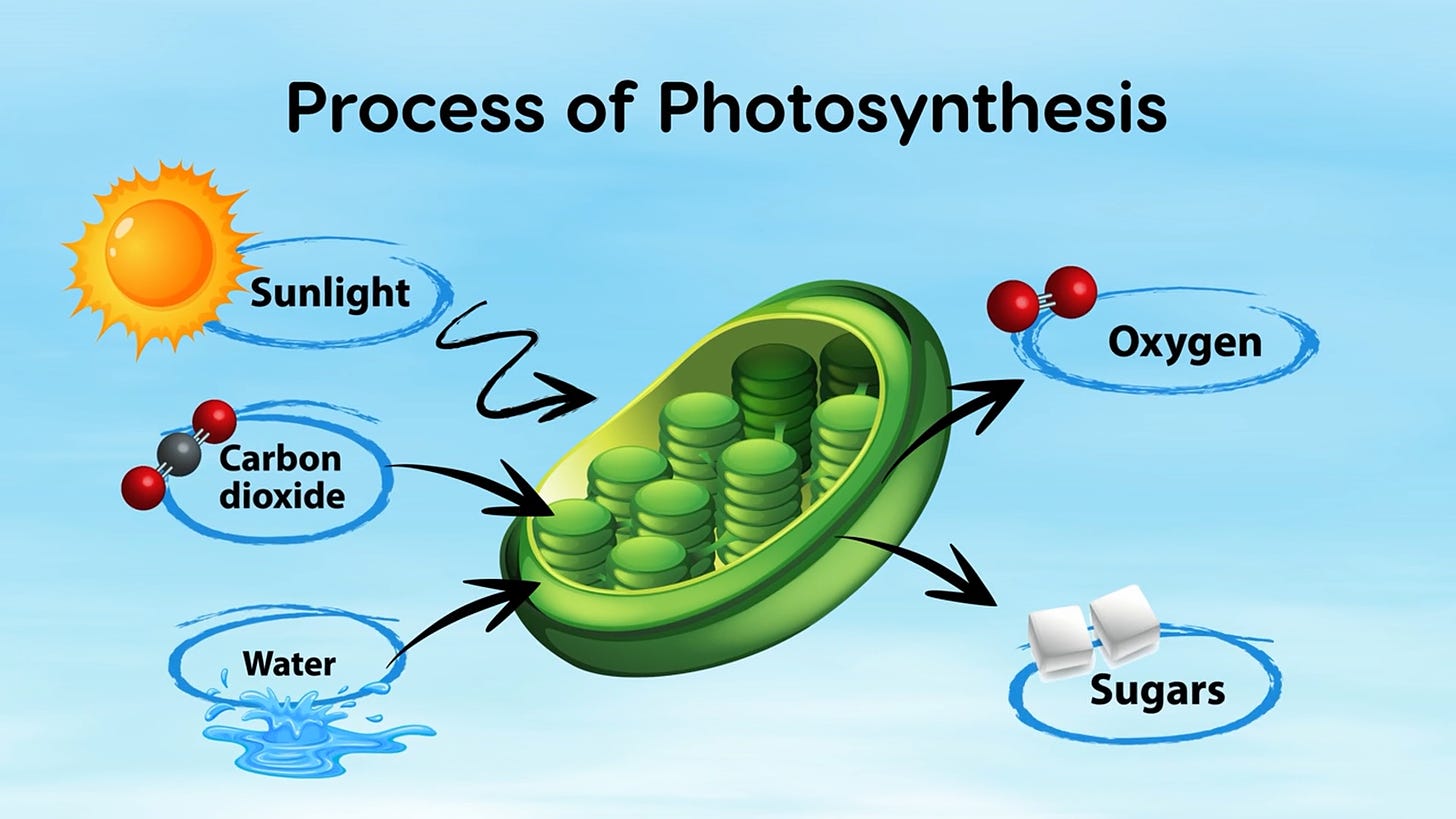The Positive Role of CO₂ in Earth's Ecosystem
Carbon dioxide (CO₂) is a colorless, odorless gas that constitutes approximately 0.0415% of the Earth's atmosphere. Despite its relatively low concentration, CO₂ plays a pivotal role in sustaining life and regulating climate patterns. Contrary to popular belief, CO₂ is not a pollutant; it is a vital component of the Earth's ecosystem, necessary for various natural processes and beneficial for biodiversity and human civilization.
Essential for Photosynthesis
CO₂ is a critical element in the process of photosynthesis, through which plants convert sunlight into energy. This process not only produces the oxygen that all aerobic organisms rely on but also serves as the foundation of the food chain. Without CO₂, photosynthesis would not occur, and life on Earth, as we know it, would not exist. According to research, increased CO₂ levels can enhance plant growth, leading to more robust ecosystems and greater agricultural yields (Drake, Gonzalez-Meler, & Long, 1997). This topic will be covered further in chapter three.
Regulating the Earth's Temperature
CO₂ is a greenhouse gas that plays a significant role in regulating the Earth's temperature through the greenhouse effect. This natural process helps to keep the planet warm enough to sustain life by trapping heat from the sun in the atmosphere. As sunlight reaches the Earth's surface, it is absorbed and then radiated back as infrared energy. CO₂ and other greenhouse gases absorb this infrared radiation, preventing it from escaping into space and thereby warming the planet. This mechanism is essential for maintaining the temperatures necessary for the diverse ecosystems and human societies that thrive on Earth. It is important to note that the warming effect of CO₂ declines logarithmically as its concentration increases, meaning that each additional unit of CO₂ has a progressively smaller impact on temperature (Lindzen, 1990). This logarithmic relationship indicates that the Earth's climate system has a built-in resilience to higher levels of CO₂, ensuring that temperature regulation remains balanced. Understanding this complex interaction is crucial for developing informed environmental policies that recognize the essential role of CO₂ in sustaining life on our planet.
Natural Homeostasis
The Earth's atmosphere and biosphere have a remarkable ability to regulate CO₂ levels. Through processes like photosynthesis, respiration, and oceanic absorption, CO₂ levels are naturally balanced. The logarithmic relationship between CO₂ concentration and warming indicates that the Earth's climate system is less sensitive to higher levels of CO₂ than often portrayed (Lindzen, 1990). This dynamic equilibrium ensures that CO₂ does not reach levels that could be detrimental to life on Earth. Furthermore, geological processes such as rock weathering and volcanic activity also contribute to the long-term regulation of atmospheric CO₂ (Berner & Kothavala, 2001). This non-linear effect is crucial for understanding how the atmosphere balances CO₂ levels and temperatures.
Promoting Biodiversity
Higher levels of CO₂ can lead to increased biodiversity. Plants absorb CO₂ and convert it into organic matter, which serves as food for herbivores. This, in turn, supports carnivores and omnivores higher up the food chain. Elevated CO₂ levels can enhance plant productivity, thus supporting a more diverse and abundant range of species. Studies have shown that during periods of higher CO₂ concentrations, such as the Mesozoic era, biodiversity flourished, with lush vegetation supporting diverse life forms (Berner, 2006).
Beneficial for Human Civilization
Human civilizations have historically thrived during periods of higher CO₂ levels and warmer climates. Warmer periods, known as interglacials, have often coincided with the rise of great civilizations due to the more favorable growing conditions for crops and less harsh living conditions. Enhanced CO₂ levels can lead to increased agricultural productivity, ensuring food security and supporting larger populations (Idso, 1989).
Conclusion
Understanding the dynamics of CO₂ emissions and absorption is crucial for addressing claims of climate change catastrophe and ensuring environmental balance. In conclusion, CO₂ is an essential, natural component of the Earth's atmosphere that sustains life through photosynthesis, promotes biodiversity, supports human civilization, and helps regulate the planet's temperature. The logarithmic decline in the warming effect of CO₂ as its concentration increases further demonstrates the complexity and resilience of Earth's climate system. Understanding the positive aspects of CO₂ can lead to a more balanced perspective on environmental policies and the role of greenhouse gases in our atmosphere.
References
Berner, R. A. (2006). GEOCARB III: A Revised Model of Atmospheric CO2 over Phanerozoic Time. American Journal of Science, 301(2), 182-204.
Berner, R. A., & Kothavala, Z. (2001). GEOCARB III: A Revised Model of Atmospheric CO2 over Phanerozoic Time. American Journal of Science, 301(2), 182-204.
Drake, B. G., Gonzalez-Meler, M. A., & Long, S. P. (1997). More Efficient Plants: A Consequence of Rising Atmospheric CO2?. Annual Review of Plant Biology, 48, 609-639.
Idso, S. B. (1989). Carbon Dioxide and Global Change: Earth in Transition. IBR Press.
Lindzen, R. S. (1990). Some Coolness Concerning Global Warming. Bulletin of the American Meteorological Society, 71(3), 288-299.
Join the KICLEI Movement! 🌍
Unlock the potential of localism and environmental stewardship with KICLEI. Explore our mission, get involved, and stay updated through our various platforms:
Join the KICLEI Network
KICLEI Mission: Join Us
Action Plan
KICLEI Action Plan: Share the Mission
Social Media & Video Platforms
YouTube: KICLEI Canada
Rumble: KICLEI Canada
BitChute: KICLEI Channel
X (Twitter): @kiclei_canada
TikTok: Maggie Dingman
Facebook: Gather 2030
Newsletter & Updates
KICLEI | Gather 2030 | Substack: Subscribe Now
Gather 2030 | Substack: Stay Informed
KICLEI Merch
KICLEI Store: Shop Now
Contribute
Donate to KICLEI: Support Our Mission
Register for Friday Zooms
Weekly Zoom Meetings: Join Us on Fridays
Press Kit
Maggie Braun's Press Kit: Download Here
Contact Us
For more information, collaboration, or to join our cause, reach out to us at: Email: info@kiclei.ca | gather2030@gmail.com








Wonderful post! There are climate readings from geological formations as well that prove there were times in history - around the Renaissance period where our global temperatures were several degrees warmer and provided for a much more lush growth. Also proof that we are just coming out of the most recent ice age and so warming is a good thing. (Both points are discussed in the videos of Escaping Calypsos Island: A Journey OUT of Our Green DELUSION mini-docuseries by Cynthia Chung).
https://youtu.be/-pX1Hf3U2tM?si=Dxf0PDzoT6G7f14-
You may also want to read a fellow CDN researchers posts. https://open.substack.com/pub/elizabethnickson/p/geo-engineering-is-the-most-dangerous?r=1b895l&utm_campaign=post&utm_medium=web
Good stuff. Thank you.